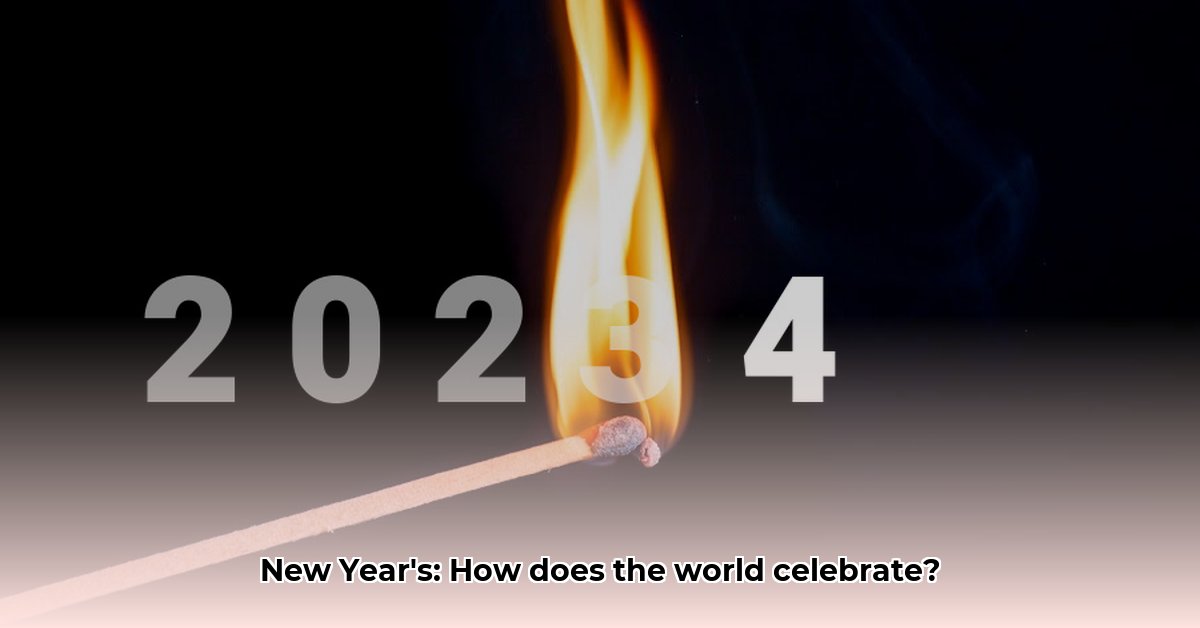New Year’s Eve. A night of reflection, anticipation, and vibrant celebrations across the globe. While the Times Square ball drop might be iconic, countless other unique traditions mark this special occasion. From quiet rituals to boisterous parties, cultures everywhere embrace the spirit of renewal and look forward to a brighter future. Let’s embark on a journey to explore these fascinating customs, delving into their history, symbolism, and how you can participate.
Festive Feasts and Fortune-Bringing Foods
Food often takes center stage in New Year’s celebrations, with many cultures believing that what you eat can influence your luck in the coming year.
Spain’s Twelve Grapes of Fortune
As the clock strikes twelve, Spaniards race against time to eat twelve grapes—one for each month of the year. Each grape represents a wish for good luck in the corresponding month. Some believe that successfully swallowing all twelve before the final chime guarantees a prosperous year.
Want to try it?
- Gather Your Grapes: Select twelve small, seedless grapes. Trust us, seeds can be a real distraction!
- Countdown to Midnight: Keep an eye on the clock, whether it’s on TV, online, or a trusty timepiece.
- Ready, Set, Gobble! As the clock begins to chime, pop those grapes in one by one. Pace yourself – it’s a marathon, not a sprint!
- Victory (Hopefully): If you conquer all twelve grapes before the last chime, congratulations! You’ve embraced the Spanish tradition and invited good fortune into your year.
Hoppin’ John: A Southern Staple for Prosperity
In the Southern United States, families gather to enjoy Hoppin’ John, a hearty dish of black-eyed peas and rice. The peas, resembling coins, symbolize prosperity, while the rice represents abundance. Some add greens, like collard greens or kale, said to resemble paper money, further enhancing the dish’s auspicious symbolism.
A World of Culinary Customs
From Japan’s long noodles symbolizing longevity to Denmark’s playful tradition of smashing plates on friends’ and families’ doorsteps (representing a breaking with the past and strengthening bonds), culinary traditions add a delicious dimension to New Year’s festivities around the world.
Rituals and Symbolic Celebrations: Embracing the New Year
Beyond the feasts, unique rituals add magic and symbolism to New Year’s celebrations.
Scotland’s First-Footer: A Harbinger of Good Fortune
In Scotland, “first-footing” dictates that the first person to enter a home after midnight influences the household’s luck for the year. Traditionally, a dark-haired man bearing symbolic gifts is considered most auspicious. Gifts like coal (for warmth), salt (for prosperity), shortbread (for food), and whisky (for cheer) each carry their own significance. While some theories link this preference to the Viking era, where blonde strangers might have meant trouble, its exact origins are still being researched.
Colorful Underwear and Other Global Customs
In many Latin American countries, people wear colorful underwear on New Year’s Eve, believing the color will influence their fortunes. Red signifies love, yellow represents money, and other colors carry various symbolic meanings. This lighthearted tradition adds a splash of color to the festivities, reflecting a festive mindset and the hopes for the new year.
A Glimpse at Global Greetings: A World of Welcomes
| Tradition | Country/Region | Description |
|---|---|---|
| Twelve Grapes | Spain | Eating twelve grapes at midnight, one for each month, symbolizes good luck and prosperity for the coming year. |
| Hoppin’ John | Southern US | This dish of black-eyed peas and rice, often with greens, symbolizes prosperity and abundance. |
| First-Footing | Scotland | The first person to enter a home after midnight, often bearing symbolic gifts, is believed to influence the household’s luck. |
| Colored Underwear | Latin America | The color of underwear worn on New Year’s Eve is believed to influence fortune in specific areas, such as love or prosperity. |
| Oliebollen | Netherlands | These deep-fried dough balls, similar to doughnuts, offer a sweet start to the new year. |
| Plate Smashing | Denmark | Throwing broken dishes at neighbors’ doors symbolizes breaking with the past and strengthening bonds. |
| Burning Effigies | Ecuador | Burning effigies representing worries and anxieties symbolizes a purging of negativity. |
| Ocean Offering | Brazil | Offering white flowers to Yemanjá, the goddess of the sea, expresses gratitude and hopes for blessings. |
| Toshikoshi Soba | Japan | Eating long buckwheat noodles (toshikoshi soba) symbolizes longevity and a smooth transition into the new year. |
| Vasilopita | Greece | A cake with a hidden coin baked inside. Whoever finds the coin is said to receive good luck in the new year. |
| Red Envelopes | China | Giving red envelopes filled with money symbolizes good luck and prosperity during Chinese New Year celebrations. |
Crafting Your Own New Year’s Traditions
Feeling inspired? Infuse your own celebration with international flair! Try making Hoppin’ John, host a grape-gobbling challenge, choose colorful underwear, or create your own unique ritual. The beauty of traditions lies in their adaptability. Borrow, adapt, and create your own meaningful ways to embrace the spirit of renewal and welcome the possibilities of a fresh start.
Why We Celebrate: More Than Just Marking Time
New Year’s is more than just the flip of a calendar page. It’s a time for reflection, renewal, and setting intentions for the future. These global traditions offer a powerful lens into diverse cultural perspectives, highlighting both our differences and our shared humanity. From planting underwater New Year’s trees in Russia’s Lake Baikal to the dazzling spectacle in Times Square, each celebration tells a story of hope and renewal. As you celebrate this New Year’s Eve, consider embracing a tradition from another culture, enriching your experience and broadening your understanding of the world.
It’s important to note that traditions evolve, and interpretations can differ even within a single culture. Ongoing research continues to illuminate the origins and meanings of these fascinating customs, and our understanding of them is likely to deepen over time. Scholars are constantly exploring the historical and cultural nuances of these celebrations, suggesting that there’s always more to learn about these rich traditions.







